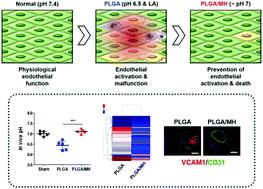当前位置:
X-MOL 学术
›
Biomater. Sci.
›
论文详情
Our official English website, www.x-mol.net, welcomes your feedback! (Note: you will need to create a separate account there.)
The antagonistic effect of magnesium hydroxide particles on vascular endothelial activation induced by acidic PLGA degradation products
Biomaterials Science ( IF 6.6 ) Pub Date : 2020-11-27 , DOI: 10.1039/d0bm01656j Kyoung-Won Ko 1, 2, 3, 4 , Bogyu Choi 1, 2, 3, 4 , Eun Young Kang 1, 2, 3, 4 , Sang-Woo Shin 1, 2, 3, 4 , Seung-Woon Baek 1, 2, 3, 4 , Dong Keun Han 1, 2, 3, 4
Biomaterials Science ( IF 6.6 ) Pub Date : 2020-11-27 , DOI: 10.1039/d0bm01656j Kyoung-Won Ko 1, 2, 3, 4 , Bogyu Choi 1, 2, 3, 4 , Eun Young Kang 1, 2, 3, 4 , Sang-Woo Shin 1, 2, 3, 4 , Seung-Woon Baek 1, 2, 3, 4 , Dong Keun Han 1, 2, 3, 4
Affiliation

|
Although drug-eluting stents (DESs) are mainly coated with biodegradable polymers such as PLGA and PLLA, their acidic degradation products can alter the local microenvironment and affect the homeostasis of adjacent tissue. Previously, we developed anti-inflammatory PLGA-based materials including magnesium hydroxide (MH) to relieve the side effects caused by PLGA degradation. However, the underlying molecular mechanism of its protective effects has not yet been clarified. Here, we demonstrated the pathological mechanism of vascular endothelial activation caused by PLGA by-products. The PLGA by-products accumulated in HCAECs through MCT1, followed by oxidative stress and the activation of the MAPK/NF-κB signaling pathway. Finally, the PLGA by-products increased the expression of VCAM-1 as well as the secretion of proinflammatory cytokines. However, the addition of MH particles significantly diminished the activation of this molecular pathway and the expression of inflammation-related factors induced by acidic PLGA degradation products. Furthermore, Mg2+ released from MH particles restored endothelial function in both intracellular and extracellular spaces. Taken together, MH particles prevent the accumulation of PLGA degradation products in HCAECs, thereby repressing the associated vascular endothelial activation. These findings on the biochemical mechanisms are expected to provide important clues for addressing the safety issues in nearly all biodegradable polymer-based implants.
中文翻译:

氢氧化镁颗粒对酸性PLGA降解产物诱导的血管内皮活化的拮抗作用
尽管药物洗脱支架(DES)主要涂覆有可生物降解的聚合物,例如PLGA和PLLA,但它们的酸性降解产物会改变局部微环境并影响邻近组织的体内平衡。以前,我们开发了基于抗炎PLGA的材料,包括氢氧化镁(MH),以缓解PLGA降解引起的副作用。但是,其保护作用的潜在分子机理尚未阐明。在这里,我们证明了PLGA副产物引起的血管内皮活化的病理机制。通过MCT1在HCAEC中积累的PLGA副产物,随后是氧化应激和MAPK /NF-κB信号通路的激活。最后,PLGA副产物增加了VCAM-1的表达以及促炎细胞因子的分泌。然而,MH颗粒的添加大大减少了该分子途径的激活以及酸性PLGA降解产物诱导的炎症相关因子的表达。此外,镁从MH颗粒释放的2+恢复了细胞内和细胞外空间的内皮功能。总而言之,MH颗粒可防止HCAEC中PLGA降解产物的积累,从而抑制相关的血管内皮活化。这些关于生化机制的发现有望为解决几乎所有可生物降解的聚合物基植入物的安全性问题提供重要线索。
更新日期:2020-12-16
中文翻译:

氢氧化镁颗粒对酸性PLGA降解产物诱导的血管内皮活化的拮抗作用
尽管药物洗脱支架(DES)主要涂覆有可生物降解的聚合物,例如PLGA和PLLA,但它们的酸性降解产物会改变局部微环境并影响邻近组织的体内平衡。以前,我们开发了基于抗炎PLGA的材料,包括氢氧化镁(MH),以缓解PLGA降解引起的副作用。但是,其保护作用的潜在分子机理尚未阐明。在这里,我们证明了PLGA副产物引起的血管内皮活化的病理机制。通过MCT1在HCAEC中积累的PLGA副产物,随后是氧化应激和MAPK /NF-κB信号通路的激活。最后,PLGA副产物增加了VCAM-1的表达以及促炎细胞因子的分泌。然而,MH颗粒的添加大大减少了该分子途径的激活以及酸性PLGA降解产物诱导的炎症相关因子的表达。此外,镁从MH颗粒释放的2+恢复了细胞内和细胞外空间的内皮功能。总而言之,MH颗粒可防止HCAEC中PLGA降解产物的积累,从而抑制相关的血管内皮活化。这些关于生化机制的发现有望为解决几乎所有可生物降解的聚合物基植入物的安全性问题提供重要线索。



























 京公网安备 11010802027423号
京公网安备 11010802027423号